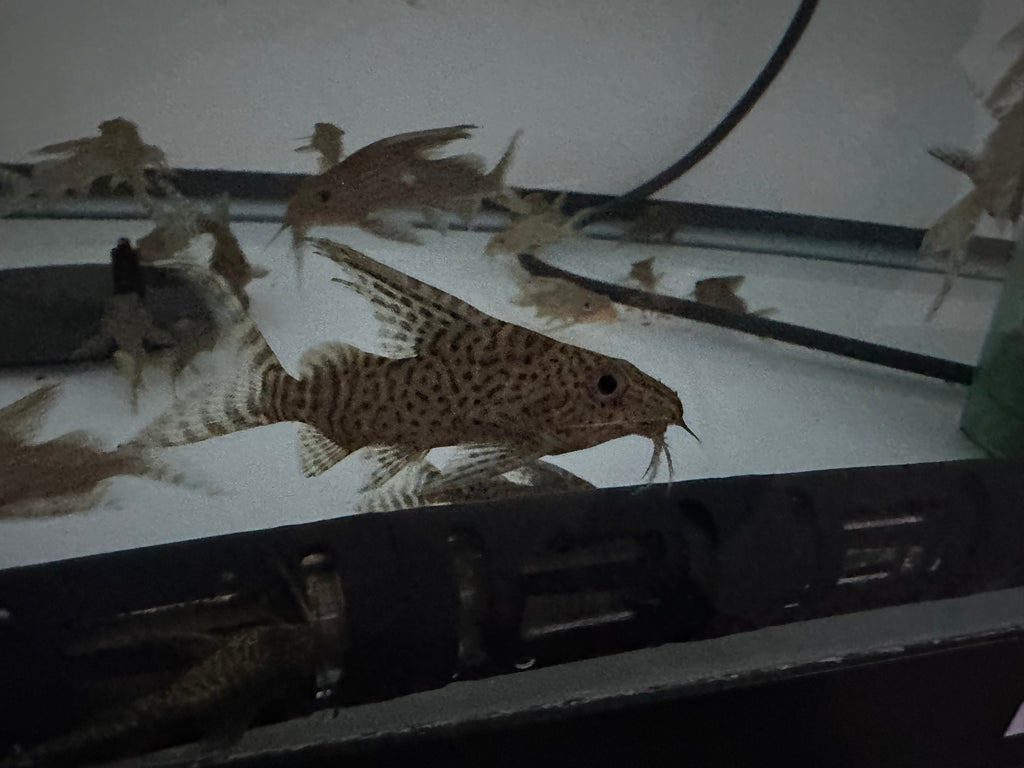Synodontis Eupterus Catfish
The Featherfin Catfish is found in various habitats across the Chad, Cross, Kwa Ibo, Niger, Volta, and White Nile basins. This bottom-dwelling fish is known for its attractive color pattern, which changes as it matures. The reticulated markings gradually transform into simple spots, and as the fish grows, a distinctive high dorsal fin develops. The first few fin rays elongate and become feathery, resembling an elaborate fan when spread wide.
To accommodate Featherfin Catfish, it is recommended to provide a spacious aquarium, especially for juveniles (at least 4 feet long). A soft sandy substrate is essential to protect their long sensory barbels. The tank should be decorated with bogwood, rocky caves, PVC tubes, and robust plants to create shady areas, while still leaving enough open swimming space at the front of the tank. External canister filtration is advisable due to their voracious appetite and the potential for a fair amount of waste production. Well-oxygenated water with a moderate current is preferred, and regular partial water changes are necessary to maintain low nitrate levels.
Featherfin Catfish are most comfortable in aquariums with subdued lighting. Using blue-moon type illumination allows for observation of their nocturnal behavior. Multiple Featherfin Catfish can be kept together as long as there are plenty of hiding places and visual barriers within the tank. These catfish often rest in the upside-down Synodontis position under plants or decorations. It's important to cover heaters with guards to prevent them from getting burned when seeking dark crevices to rest against. Compatible tankmates should be peaceful and larger than 5 cm (2 inches) in length. Suitable companions may include medium-sized tetras, barbs, gouramis, knifefish, large loricariids, rainbowfish, or robust West African cichlid species. However, they should not be kept alongside Malawi or Tanganyikan cichlids due to their aggressive nature and incompatible water conditions.
Feeding-wise, Featherfin Catfish are omnivorous. They should be offered a variety of meaty frozen foods such as bloodworms, white mosquito larvae, vitamin-enriched brine shrimp, and Mysis shrimp. Sinking catfish pellets, tablets, or granules can also be included in their diet. It's important not to overfeed them, as they are prone to bloating. Dried foods should be given sparingly, and floating foods should be avoided.
Breeding Featherfin Catfish in home aquariums is uncommon, but they are commercially bred via hormone injection. In the wild, they form distinct breeding pairs and are egg scatterers. However, they exhibit no parental care.
It's worth noting that Featherfin Catfish may also be sold under the names Featherfin Squeaker or Featherfin Synodontis. While they are commonly available, they are not ideal for average community aquariums. Smaller setups may be better suited for slightly more petite species such as the Upside Down Catfish (S. nigriventris).

